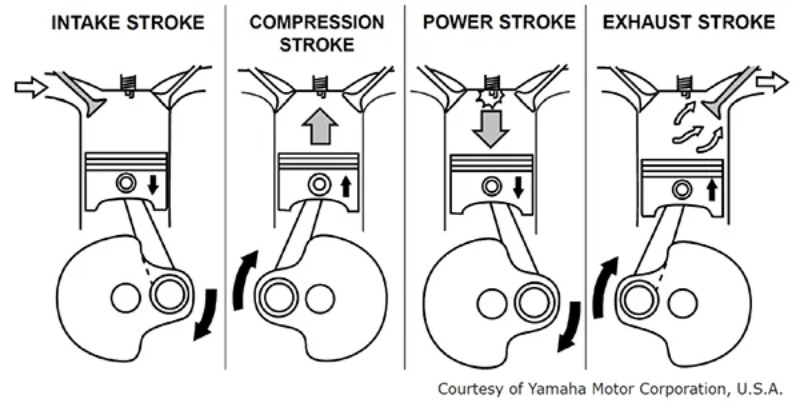Ask The Editors: How Many Strokes Can an Engine Have?
Well for starters, that is not a stupid question by any means. It is however, a fairly complicated one. Let’s start with the basics – “stroke” is another word for cycle. And cycle is a lot better at explaining what’s going on inside. A four cycle engine means exactly that – there are four cyclic processes (or cycles) happening for every complete operation. In other words, the piston takes two complete strokes (down, up, down up) per cycle. This requires two revolutions (720°) of a crankshaft – one to open and close the intake valve(s) and another to open and close the exhaust valve(s). Until electric motors take us over, the four cycle or 4 stroke engine is going to come standard on every ATV you ride.

The two cycle (or 2 stroke) didn’t actually come first, having been invented in 1879 by German Karl Benz (compared to the patent of the four cycle in 1862). As the name suggests, this design required only a single piston stroke (down, up) to complete the operating cycle. Rather than depending on a crankshaft to time the opening and closing of intake and exhaust valves, the 2 stroke boasts a compression stroke, followed by the ignition of compressed fuel each time. When the piston returns, the exhaust is pushed out by the fresh fuel moving into the cylinder.
The 2 stroke once ruled the roost in the quad world as well, with entries offered by nearly every major manufacturer, some to nearly legendary reputation (like Yamaha’s Banshee 350 and Suzuki’s Quadzilla 500).
Though more efficient from an energy output perspective, the two cycle has fallen out of favor out of environmental concerns – namely the high number of harmful hydrocarbons in the exhaust produced, which itself is typically heavier due to the presence of oil mixed with the fuel to serve as top end lubrication.
Now as for the minimum and maximum number of cycles – this is a bit trickier. As cycles or strokes refer simply to how many operations it takes to complete a power output unit, there is really no limit. And no, these are not limited to even numbers as engine designs are not limited to the ups and downs of a single piston per cylinder.
For example, the patent for the 3 stroke engine demonstrates a design where one cycle consists of exhaust, intake, compression, ignition, and expansion within a single revolution of a crankshaft by one stroke of a first piston and a single stroke of a second piston within a single cylinder.
The five cycle engine, developed in 2000, integrates pressure chambers into its operating cycle. To summarize, exhaust gas, rather than simply being pushed out of the exhaust, is fed from a high pressure cylinder into a low pressure one per each cycle, allowing the the internal compression ratio to be changed instantaneously.
We have seen sketches of seven and eight cycle internal engine designs that rely upon electrical processes such as pump driven oil relocation and cylinder reconfiguration as a part of each operating cycle.
And before you ask, yes, there has been a single stroke internal engine developed too. The patent for that one can be viewed here.


